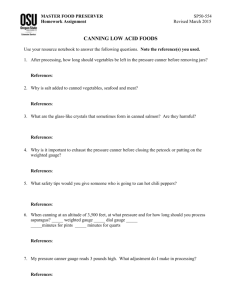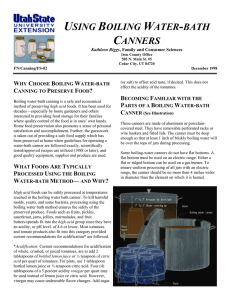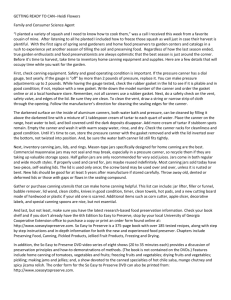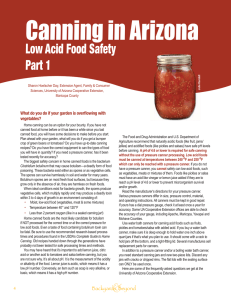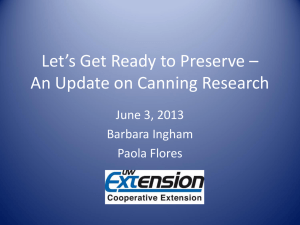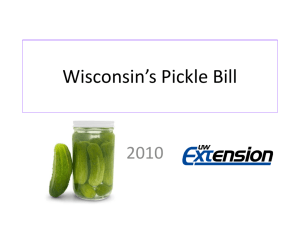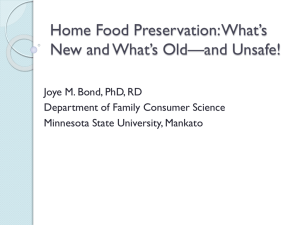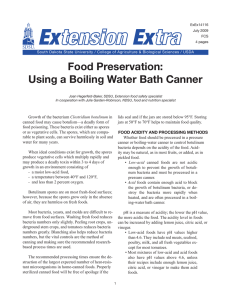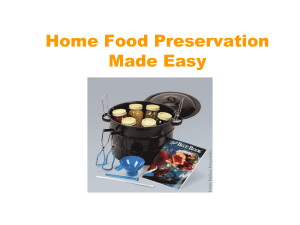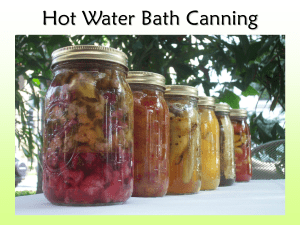Home Canning Basics - University of Rhode Island
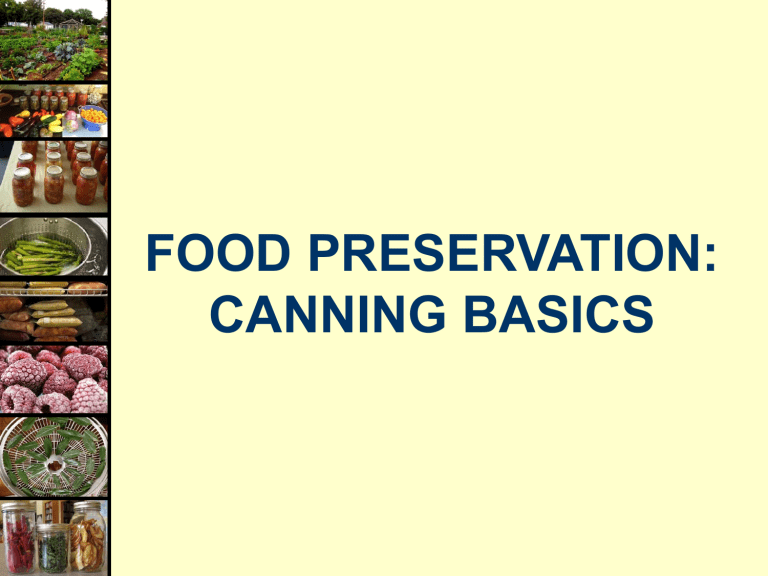
FOOD PRESERVATION:
CANNING BASICS
Preserving Food
Main home food preservation methods
•
Canning
•
Freezing
•
Drying
Choice of method depends upon
•
Safe guidelines
•
Product characteristics
To maintain safety and quality
•
Microorganisms
•
Enzymes
How Preservation Methods Work
Freezing reduces the temperature
Drying removes moisture
Canning applies heat
Principles of Canning
Heat processing at specified temperature for a specified time
•
Destroy organisms
•
Inactivate enzymes
•
Oxygen driven out
A Vacuum is formed upon cooling
•
Prevent recontamination
4
Home Canning Basics
Recommend research-based recipes:
•
USDA
•
Land grant universities
•
Ball ® Blue Book (dated 1989 or later)
Time, temperature, product volume scientifically tested
If recipe not followed correctly
•
Poor quality product
•
Food poisoning
•
Death
5
Two Approved Methods of Canning Foods At Home
Boiling Water Bath (212 °F)
•
Acidic foods ( pH ≤ 4.6
)
•
Addition of acidic ingredients
Pressure Canning (240 °F)
•
Low-acid foods ( pH ≥ 4.6
)
•
Mixtures of acid and low-acid foods
6
pH = Acidity
Acidity measurement = pH scale 0 – 14
Low pH values = high acidity
Different bacteria, different acid tolerance
Bacteria grow between pH 4.6 and 9.0
Bacteria thrive between pH 6.0 and 7.5
Vinegar
7
Acidic Foods
pH < 4.6
Fruits
Tomatoes, figs, pears are borderline – require acidification
Fermented foods (sauerkraut, pickles) – yeasts breakdown carbohydrates, ↑ acidity
Can be safely heat processed in boiling water
8
Low-Acid Foods
pH > 4.6
Vegetables
Meats, poultry, seafood
Soups, stews
Mixtures of acid and low acid foods (spaghetti sauce – meat, vegetables and tomatoes)
Must be heat processed in a pressure canner
9
10
Why Two Methods?
Clostridium botulinum
Commonly found in soil and marine sediment
Two forms
•
Vegetative cells
•
Spore
Vegetative cells killed at 212 o F
Spores destroyed at 240 o F
If do not destroy spores, they will germinate into vegetative cells when conditions become favorable and produce toxin
11
Botulism Poisoning
Favorable conditions for C. botulinum grothw:
•
Low oxygen
•
Low acidity (pH >4.6)
•
Moisture
•
Temperature spore germinates bacterium growth
(multiplies) waste materials and toxins
12
Botulism Foodborne Illness
Symptoms appear within 12 to 72 hours:
•
Nausea, vomiting, weakness, dizziness
•
Blurred, double vision
•
Difficulty swallowing, speaking and breathing
•
Possible death from suffocation
13
Botulism Foodborne Illness
Potentially fatal
Permanent nerve damage
Food can contain toxin without showing signs of contamination
Improperly home canned vegetables remain the leading cause
14
Foodborne Botulism
Outbreaks in US
116 reported outbreaks from 1999-2008 a
•
75 (91%) caused by home-prepared foods
•
33 (44%) home-canned foods
Home canned vegetables significant cause a
•
Preserving low acid food improperly
•
Modifying instructions
•
Low awareness of risk of botulism
15 a Journal of Food Protection, Vo. 74, No. 12, 2011, Pages 2090-2096.
16
Preventing Botulism
Follow the recipeNO MODIFICATIONS!
Several factors affect heat penetration
•
Jar
•
Food
Cold-spot
•
Slowest heating area of the jar
•
Determines process time
Use recommended canners
•
Heat-up and cool-down times in pressure canner are counted toward “sterilization”
•
DO NOT RUSH!!!
17
EQUIPMENT
18
Equipment - Jars and Lids
Jars
Don’t use if chipped
Keep hot
Processing <10 min. = must be sterilized
Lids
ALWAYS use new flat lids
Lid has a sealing compound filled channel
Keep hot until used
Threaded screw band
19
Vacuum Seal
Heat-processed and cooled
Pressure outside of jar > inside jar
•
Pushes lid down
•
Sealing compound conforms to rim
•
Creates air tight seal
Prevents recontamination of the food
Failure to adequately heat-process
= seal failure, food spoilage, health risks
20
Packing Methods –
Raw/Cold Pack
Raw, unheated food
Boiling liquid poured over the food
Tightly pack fruits and most vegetables because that will shrink during processing
Loosely pack starchy vegetables that will expand during processing
21
Packing Methods –
Hot Pack
Put hot food and boiling liquid into jars
Pack fairly loosely because shrinking already occurred
Make sure enough cooking liquid covers the food
Preferred method for most foods
Note: If directions say only hot pack then hot pack!
22
Headspace
Empty space
Allows food to expand
Allow for good vacuums to be formed
23
Headspace
TOO LITTLE
= PREVENT SEALING
TOO MUCH
= AIR IN JAR
= PREVENT SEALING
= FOOD DISCOLOR
24
Air Bubbles
Rise during processing
= Too much headspace
= Prevent sealing
To prevent air bubbles
•
Run a plastic or rubber knife-like utensil around the edges of the jar
•
Gently shift the food
More liquid may need to be added to ensure proper headspace
25
Boiling Water Bath
Canner
Water: 1-2 inches MUST cover the jars
Place ALL jars in canner
Start timer when water returns to a boil
Cover
DO NOT DISTURB jars for 12-24 hours
26
Pressure Canning
Water: 2-3 inches
Place jars in canner
Heat the pressure canner until steam comes out of the vent tube
Allow steam to vent for 10 min.
Process times are for a pure steam environment
USDA instructs to vent ALL pressure canners
DO NOT DISTURB jars for 12-24 hours
If pressure drops anytime during the process, bring the canner back up to required pressure and start timing the process over, from the beginning
27
Pressure Canners vs. Cookers
NOT INTERCHANGEABLE!
Canners MUST hold at least 4 quart-size jars
Cookers have less metal, smaller diameter, and use less water
= shorter processing time
= reduced heat
= under processed product
= risk of botulism!
National Center for Home Food Preservation
Preserving Food: Using Pressure Canners http://nchfp.uga.edu/publications/uga/using_press_canners.html
28
Pressure Canners Features
Dial Gauge
Indicates pressure inside the canner
Must be checked for accuracy
Has dead- or counter-weight to close open vent for pressurizing
Adjust heat to maintain pressure
30
Pressure Canners Features
Weighted Gauge
Weights regulate pressure inside the canner – 5, 10, 15 lb.
Open vent is where the weights fit
Steam, exhausted during processing, causes the weights to rock or jiggle
Does not require testing for accuracy, but replace the weights if they become damaged
31
Storing Home Canned Food
Label and date
Store without ring bands
Store in cool, dark, dry place
Refrigerate unsealed jars
Avoid temperature extremes
For best quality, use within a year
32
Disclaimer:
Trade and brand names are used only for information. The University of Rhode Island does not guarantee nor warrant published standards on any product mentioned; neither does the use of a trade or brand name imply approval of any product to the exclusion of others which may also be suitable.
Document Use:
Adapted with permission of the University of Georgia. Harrison, J.A. 2008. Canning
Foods at Home – The Basics (slides). Athens, GA: The University of Georgia, Cooperative
Extension.
So Easy to Preserve, 5th Edition, 2006, University of Georgia Cooperative Extension
Service
Adapted with permission of the University of Georgia. Andress, E.L. 2003. Freezing fruits and vegetables at home (slides). Athens, GA: The University of Georgia, Cooperative
Extension Service.
Adapted with permission of the University of Illinois. Finck, J. 2011. Drying Foods (slides).
Springfield, IL: The University of Illinois, Extension.
Ball® Complete Book of Home Preserving, Ed. J. Kingry and L. Devine, 2006. Robert
Rose Inc.
Photography Credits
Elizabeth Andress and Elaine D’Sa, National Center for Home Food Preservation,
University of Georgia.
Information Staff, Agricultural Research Service, USDA.
North Caroline State University
33

